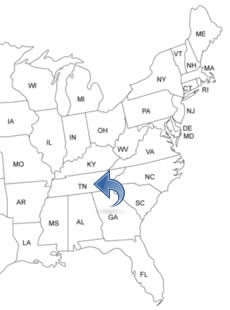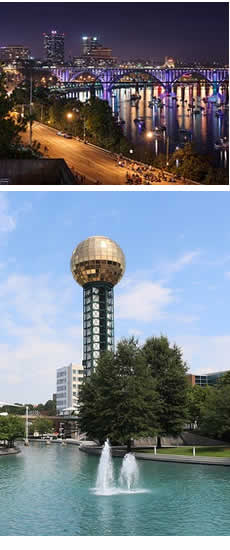TENNESSEE PEOPLE SEARCH!
- ✔ Contact Info
- ✔ Phone Numbers
- ✔ Criminal Records
- ✔ Income Info
- ✔ Neighbors
- ✔ People's Age
- ✔ Property Ownership
- ✔ And Much More
Knoxville, Tennessee
Knoxville is located in the central-eastern part and is the third largest city in the U.S. State of Tennessee. Knoxville was the first capital of Tennessee. The city is home to more than 20 museums and has many festivals, concerts, and cultural attractions throughout the year. Knoxville is ranked as one of the best cities to reside for both the US and Canada and among the top 10 Metropolitan Hotspots in the United States.
To See And To Do In Knoxville
- Old City
- House Mountain State Natural Area
- Knoxville's Riverwalk Volunteer Landing
- Museum of East Tennessee History
- Knoxville Museum of Art
- Gay Street
- Candy Factory
- Market Square
- Knoxville Zoo
- Knoxville Center
- The Smoky Mountains
- Marble Springs
- Tennessee River Boat
- Krutch Park
- Bleak House
- Fort Sanders Neighborhood
- The Mabry-Hazen House
- Ramsey House
- World's Fair Park
- William Blount Mansion
- White's Fort
- The University of Tennessee Gardens
- Fishing
- Candoro Marble Works
- West Town Mall
- Frank H. McClung Museum
History Of Knoxville - Timeline
In 1540, the Spanish expedition of Hernando de Soto is believed to have been the first Europeans to visit the region.
In 1783, James White, James Connor, Robert Love, and Francis Alexander Ramsey discovered the future site of Knoxville. In 1786, James White built the White Fort and a mill. He was the first known permanent settler of Knoxville. There were other settlers near the site at the time and James White and the land speculator William Blount tried to resolve land disputes between the Cherokee and the white settlers in the region.
In 1787, the town was founded and in 1791, the community was named Knoxville. In 1792, more settlers arrived and a blockhouse was built and the Blount Mansion was built. It was the home and territorial Capitol of Governor William Blount. Also in 1792, Nathaniel and Samuel Cowan opened a general store, and a tavern was in operation.
In 1793, Chickamauga and Creeks massacred the inhabitants of Cavet's Station near the Bearden neighborhood in Knoxville. In 1794, the Blount College, known today as the University of Tennessee, was founded. In 1796, Knoxville was chosen as the capital of the state. In 1797, the Ramsey House Plantation was built. It was the first stone house in Knoxville.
In 1801, David Glasgow Farragut was born in Knoxville. He was later appointed to the rank of Admiral. It was the first ever in American History. In 1802, there were more than 200 houses in the town.
In 1815, the City of Knoxville was incorporated. In 1816, the newspaper Knoxville Register was founded and a hotel was built on Gay Street. In 1836, James White's son, Hugh Lawson White, took part in the presidential election. In 1842, the English travel writer James Gray Smith wrote that the city was home to a university, an academy, a ladies school, three churches, two banks, two hotels, and 15-20 stores.
In 1848, the Tennessee School for the Deaf opened. In 1855, the railroad was completed and the first train arrived. In 1859, the city had 6 hotels, several tanners, tinners, and furniture makers, and 26 liquor stores. In 1860, Joseph Mabry owned 42 slaves.
In 1863, the war came to the city and Civil War-related violence also occurred in Knoxville for years after the war. In 1868, the Knoxville Iron Company was established. In 1872, the first opera house in the city was built on Gay Street. In 1875, Knoxville College was founded. In 1884, the Knoxville Woolen Mills was established and a city hospital was established.
In 1885, the Brookside Mills was established. The textile industry took shape. Also in 1885, a library was established. In 1890, the first electric streetcar ran from Gay Street to Lake Ottossee. In 1897, a fire destroyed most of Gay Street.
In 1900, more than 32,600 people were living in the city. In 1901, Kid Curry shot a couple of deputies and escaped out the back window of a business on Central Avenue in what is now the Old City. He was captured and brought to the Knoxville Jail. He escaped and was last seen riding the sheriff’s stolen horse across the Gay Street Bridge. Kid Curry was a member of Butch Cassidy’s Wild Bunch.
In 1904, the first black federal judge, William Henry Hastie was born in Knoxville. In 1919, a lynch mob stormed the county jail in search of Maurice Mayes, a mulatto man who had been accused of murdering a white woman. The mob didn't find him. It is estimated that between 25 and 30 people was killed. In 1932, the Great Smoky Mountains National Park opened. In 1956, Dolly Parton began her career in Knoxville. In 1982, Knoxville was home to the World's Fair.

